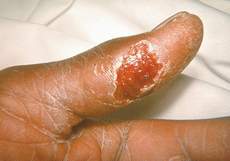Biological weapons not linked with outbreak of tularemia in Russia
A US pensioner wrote that an online journal that there were certain opportunities in several regions of Russia to conduct a warfare with the use with biological weapons

A message appeared on one of US forums on Thursday, saying that an outbreak of tularemia, or rabbit fever, in the Nizhni Novgorod region of Russia could be caused with an escape of biological weapons. The message appeared soon after Russian authorities declared that the outbreak of the infectious diseases had been localized in the region. 
The author of the message, whose posts had been subsequently published on the PHXNews website, said that there were several dangerous objects, particularly secret defense laboratories, situated in the above-mentioned region. A US pensioner, named Gene Finneranan, wrote that the outbreak of tularemia in several Russian regions could be caused with either an accidental or deliberate discharge of biological weapons. The 71-year-old resident of New Jersey published the information about it on a personal webpage on August 25.
In spite of the fact that the pensioner presented inaccurate information about the borders of Russian regions and objects, which are supposedly situated there, the pensioner's data were quoted by PHXNews the same day, on August 25. Several Russian media outlets reproduced the information about the outbreak of tularemia the next day, on August 26.
According to Gene Finneranan, 96 people have been diagnosed with tularemia in the Nizhni Novgorod region of Russia. Fifty-six incidents of the disease have been registered in the neighboring Ryazan region. The press service of the regional department of the Russian Emergency Committee confirmed the information.
The US pensioner wrote that there were certain opportunities in the Nizhni Novgorod region to conduct a warfare with the use of biological weapons. The pensioner said that there was a special laboratory in the town of Chapayevsk, which was used to destroy biological weapons. Chapayevsk, however, is situated not in the Nizhni Novgorod, but in the Samara region of Russia; local authorities planned to build a plant to destroy chemical, but not biological weapons there.
”The structure is used in the town of Dzerzhinsk of the Nizhni Novgorod region for the production of chemical weapons, particularly lewisite,” the American pensioner wrote. The department of convention problems of chemical and biological weapons of the Russian agency for ammunition told Regnum news agency that the talks about the tularemia outbreak because of an escape of chemical weapons were not  true to fact. “This is nothing but a fantasy. First off, lewisite possesses an absolutely different destructive capacity. Furthermore, tularemia is a local natural disease. It naturally appears during the summer season when the number of rodents increases. Rodents are the major carriers of the disease. No chemical weapons have anything to do with the outbreak of tularemia,” a spokesman for the department said.
true to fact. “This is nothing but a fantasy. First off, lewisite possesses an absolutely different destructive capacity. Furthermore, tularemia is a local natural disease. It naturally appears during the summer season when the number of rodents increases. Rodents are the major carriers of the disease. No chemical weapons have anything to do with the outbreak of tularemia,” a spokesman for the department said.
”Any attempts to connect the outbreak of the disease with activities of biological laboratories are absolutely groundless,” a senior specialist of the department for non-proliferation of weapons of mass destruction of the Institute of World Economics and International Relations, Natalia Kalinina said. The specialist referred to the decree from the Russian president signed in 1992. The document prohibited any scientific developments connected with biological weapons. In addition, the institute presents comprehensive data about the development of biologically protective programs to the UN, the expert said. Incidents of tularemia are absolutely natural, the expert assured, especially in southern regions.
Tularemia is a potentially serious illness that may occur naturally. It is caused by the bacterium Francisella tularensis found in animals, especially rodents. Symptoms of tularemia include: sudden fever, chills, headaches, diarrhea, muscle pains, joint pains, dry cough, progressive weakness. People can also catch pneumonia and develop chest pain, bloody sputum and can have trouble breathing and even sometimes stop breathing, Centers of disease Control and Prevention website says. Tularemia can be spread in different ways: from bites of an infected insect, or eating or drinking contaminated food or water. One can also be infected through skin cuts or damages mucous membranes. If the disease penetrates into the huiman body through skin, it usually develops a bubonic form of the sickness. Tularemia can be treated and cured with antibiotics.
Subscribe to Pravda.Ru Telegram channel, Facebook, RSS!


